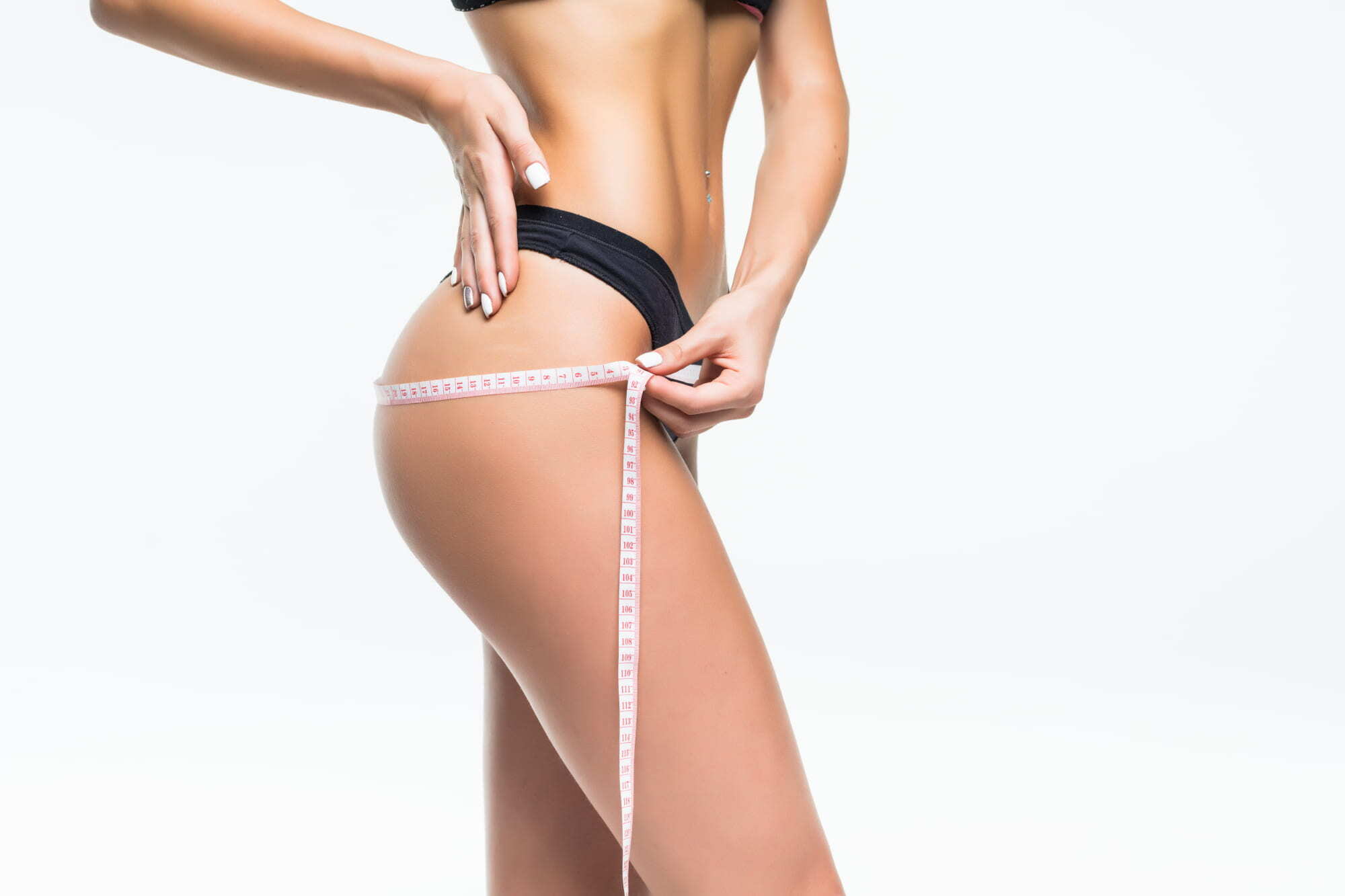
Throughout human history, numerous civilizations have revered prominent buttocks, with some even crafting fetishes dedicated to fertility goddesses characterized by their oversized posteriors. While we have stopped openly worshiping them, not a lot has changed since then.
Having a perky butt is still considered a positive beauty trait in both men and women, but not everyone can achieve it. We aren’t talking about a lack of training or commitment. We are talking about genetics, gravity, and the natural aging process. Those are the primary factors that motivate individuals to seek surgical or non-surgical butt lift procedures, also known as BBL.
How Does One Achieve a Successful Butt Lift Without Surgery?
There are three ways one can improve the look of their derrière without surgery:
- Dermal fillers
- Radiofrequency Based Treatments
- Ultherapy
Dermal Fillers
Dermal fillers like Radiesse, Sculptra, and Juvederm are the most common non-surgical methods used for everything from the face to the buttocks.
Dermal fillers are known as biostimulators. They work by stimulating collagen production in the administered area, which rejuvenates the skin, hides cellulite and other skin imperfections, improves the appearance of sagging skin, lifts and contours the area, and adds volume to it.
It’s a common misconception that Botox can also do all of this, but no. Botox is an excellent aging prevention method, but it can’t reverse the damage once it’s done. It’s not uncommon for both procedures and products like Sculptra to be used for a longer-lasting effect on the skin.
Radiofrequency Based Treatments
This non-invasive BBL method also works by stimulating the production of collagen, but instead of injecting biocompatible acids like dermal fillers, it heats up the deeper layers of skin to induce the creation of heat-shock proteins, which in turn create new collagen fibers.
While the process is virtually painless, it may be slightly disconcerting to some due to the deep layers of skin needing to reach between 122 and 167°F for the treatment to work.
Ultherapy
Ultherapy is another non-invasive method used to stimulate collagen production and elastic tissue in deeper layers of skin. However, instead of using radiofrequency to heat up the skin, it uses ultrasound technology to achieve similar results.
Unlike radiofrequency-based treatments, Ultherapy can precisely target deeper layers of the skin without causing any pain or discomfort.
It may come as a surprise that a Brazilian butt lift is not included on the list, but there are no non-surgical Brazilian butt lifts. While the process of injecting fat into the derrière is non-surgical, extracting fat with liposuction is not, and therefore the Brazilian BBL and other fat grafting procedures are surgical procedures.
Why Do People Choose Non-Surgical Over Surgical Butt Lifts?
Simply put, there are three main reasons: risk, cost, and downtime.
Risk
Any surgical procedure, whether cosmetic or non-cosmetic, inherently carries a higher level of risk due to its invasive nature and potential complications. They include, but are not limited to:
- Infections: Surgical procedures carry a risk of infection at the incision site or in the surrounding tissues, which may require additional treatment or antibiotics.
- Adverse Reactions to Anesthesia: Some individuals may experience adverse reactions to anesthesia, ranging from mild reactions like nausea and vomiting to more severe complications, such as allergic reactions or respiratory issues.
- Bleeding and Hematoma: Excessive bleeding during or after surgery can lead to hematoma formation, where blood collects and forms a clot. It may necessitate drainage or surgical intervention. Non-surgical BBL uses anesthesia, but the topical anesthesia used during the procedure has mild side effects.
- Scarring and Poor Wound Healing: Surgical incisions can result in scarring, and in some cases, the healing process may be delayed or compromised, leading to poor wound healing or keloid formation.
It is important to note that these potential complications can vary depending on the specific surgical procedure and individual factors.
Cost
It’s no secret that any medical procedure is costly, the same goes for cosmetic procedures, and it doesn’t help that most healthcare insurance policies don’t cover the costs of cosmetic surgery.
According to the American Society of Plastic Surgeons, the average cost of buttock augmentation with fat grafting is $4,341. What isn’t included in that price are the surgeon’s fee, anesthesia fees, medical tests, facility costs, and other additional costs, which easily double the price of the procedure.
Non-surgical butt lift costs are way lower. For example, the price of a dermal filler procedure depends primarily on how many vials are needed to achieve the desired results. The procedure can take anywhere between four and ten vials, with one vial costing, on average, $230.
These prices are just averages. The actual cost will vary depending on the region and the individual doctor.
Downtime
Nobody likes to be stuck in bed, and patients want to get back to their everyday lives as quickly as possible. That simply isn’t possible if incisions are required during the procedure. Depending on the procedure, one must take different aftercare steps to ensure everything heals properly.
All non-invasive methods can be done during a lunch break and require little to no downtime. Once the patient is done, they can continue their daily lives with minimal aftercare needed. The same can’t be said for surgical procedures.
Benefits of Buttock Lift Without Surgery
One of the key benefits is, naturally, a firmer and enhanced buttock contour and shape. While it is true that this outcome can also be achieved through surgical means, opting for a non-surgical approach offers a range of additional benefits. Those are:
No incisions or scars – While corrective surgery scars are minimal, they do still exist.
- Low risk – With non-invasive methods, the risk is minimal to non-existent.
- No bed rest – All the non-surgical methods mentioned do not require any bed rest.
- Minimal aftercare – There is no need for special aftercare treatments or bandages to cover up the treated area.
- Quick – Treatments take between 30 and 90 minutes per appointment.
- Inconspicuous – Nobody will notice any sudden changes. It takes between three and six months for collagen to do its magic.
- Natural – But lift treatments harness the body’s natural processes, using technologies that stimulate collagen production and promote tissue tightening to achieve a naturally enhanced buttock appearance.
They also have one common drawback: they are all semi-permanent, so follow-up treatments will be required after two to four years, depending on the treatment.
Who Is a Good Non-Surgical Buttock Lift Candidate?
The ideal candidate for a non-surgical alternative should possess the following characteristics:
Good Overall Health: Candidates should be in good overall health without any underlying medical conditions that could pose risks during the procedure or hinder the recovery process.
Mild to Moderate Sagging: Non-surgical buttock lift procedures are typically suitable for individuals with mild to moderate sagging or loss of firmness in the buttock area.
Realistic Expectations: It’s essential for candidates to have realistic expectations about the outcome of a non-surgical buttock lift. While butt lift injections can enhance the appearance, they may not achieve the same dramatic results as surgery.
Absence of Excess Weight: Non-surgical buttock lift procedures are generally more effective for individuals at or near their ideal body weight. Excess weight can affect the overall contour and may limit the effectiveness of the treatment.
It is important to consult with a qualified healthcare professional who can evaluate your specific situation and determine if you are a suitable candidate for a non-surgical buttock lift.
Conclusion
With advances in medical technology, everyone can achieve the butt of their dream. Butt lift, non-surgical and surgical, both deliver the desired results of a tighter and firmer posterior but use two different approaches. While one approach may not be suitable for everyone, the availability of non-surgical butt lift options provides a viable alternative for those who prefer a less invasive procedure.
However, it is essential for individuals to consult with qualified healthcare professionals to determine the most suitable option for their specific needs and goals. Factors such as skin elasticity, sagging severity, overall health, and individual preferences play a significant role in deciding whether a non-surgical buttock lift is the right choice.
FAQ
What are the risks of a non-surgical BBL?
Non-surgical alternatives can cause bruising and swelling, which can last up to three weeks.
What is the problem with the buttock lift?
The most common issue that can arise as a result of insufficient practitioner skill or filler migration is for the dermal filler to set incorrectly, resulting in an unnaturally lumpy appearance. If this occurs, there is nothing you can do but wait for the body to absorb it.
What not to do after non-surgical BBL?
Avoid showering the treated area for 24 hours after the treatment. Refrain from going to the gym for a week, and avoid engaging in buttock exercises for six weeks. It is advisable to avoid sunbathing in any form. Additionally, try not to sleep on your back for a week. These guidelines serve as general recommendations, but following your practitioner’s specific aftercare instructions is crucial as they may vary depending on the procedure used.
References:
- Bilateral Gluteal Augmentation With Hyperdilute Calcium Hydroxylapatite Microspheres Performed Using the Bella Vida Instant Brazilian Butt Lift (BBL); Iani Silveira and Brigitte Martinez; June 2022
- Adjustable Depth Fractional Radiofrequency Combined With Bipolar Radiofrequency: A Minimally Invasive Combination Treatment for Skin Laxity; Erez Dayan (MD), Christopher Chia (MD), A Jay Burns (MD), and Spero Theodorou(MD); April 2019
- Hyaluronic Acid Fillers: Science and Clinical Uses; Karol A Gutowski; July 2016
- Brazilian Butt Lift–Associated Mortality: The South Florida Experience; Pat Pazmiño (MD) and Onelio Garcia, Jr. (MD); February 2023
- Collagen Stimulators in Body Applications: A Review Focused on Poly-L-Lactic Acid (PLLA); Marie-Odile Christen; Jun 2022
Injectable aesthetics are popular due to their ability to provide noticeable results with minimal downtime compared to surgical procedures. They are versatile and can be tailored to meet individual aesthetic goals, whether it's enhancing lips, restoring facial volume, or smoothing out wrinkles. However, they should always be administered by qualified professionals to ensure safety and achieve optimal results.
Injectable aesthetics are used to enhance facial features, reduce the signs of aging, and improve overall facial symmetry and appearance.
Key types of injectable aesthetics include:
-
Dermal Fillers: These injectables are used to add volume, fill in wrinkles and folds, and enhance facial contours. They often contain substances like hyaluronic acid, collagen, or calcium hydroxylapatite, which help plump up the skin and smooth out fine lines and wrinkles.
-
Botulinum Toxin (Botox): Botulinum toxin injections temporarily relax facial muscles that cause wrinkles and lines to form. It is commonly used to treat forehead lines, frown lines between the eyebrows, and crow's feet around the eyes.
-
Collagen Stimulators: These injectables stimulate the body's own collagen production, helping to improve skin texture and firmness over time. Examples include poly-L-lactic acid (Sculptra) and calcium hydroxylapatite (Radiesse).
-
Neurotoxin Injections: Besides Botox, other neurotoxins such as Dysport and Xeomin are used similarly to reduce wrinkles and lines.





